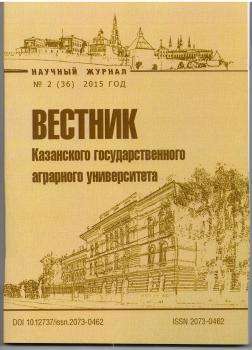Forest landscape is a natural biological complex, with specific relationships of its components (nature and environment) and the appearance of the landscape. In forest park farms to generate different types of landscapes in the optimal ratio of their stands on the composition, canopy and influence the spatial placement. The successful solution of the major problems of the city woods is based on an assessment of landscape and architectural indicators and the forecast of their structure. When carrying out actions for formation of a landscape it is necessary to present accurately the design shape of a landscape formed on this site. It can be reached when all factors influencing architectural and landscape shape of a site, are revealed with sufficient completeness. There is a need of an assessment of ecological making planting and a separate tree at design and formation of a city landscape. Baseline data to determine the environmental productivity are: species, age, and height, diameter of the trunk (trunk), diameter and height of the crown, the area of leaf surface, growth, and nutrition area of the tree. It should be emphasized that further study is necessary to consider also the indicators of the sum of the quantities of climate-forming, water protection soil protection, sanitary, recreational settings. One of the main activities to increase the environmental efficiency of Parklands are landscaped logging is thinning the forests recreational purpose, aimed at the development of forest landscape restoration and enhancement of their aesthetic, recreational value and sustainability. Landscapes logging in the green zone of Ufa as noted Khayretdinov A.F. (2007) were applied as of the 60-ies of the last century, combined with cuttings, but, not having independent meaning.
ecological productivity, a points-based assessment of plantations, landscape characteristics of the, landscape logging
Введение. Методические основы проведения ландшафтных рубок фактически отсутствуют, их критерии, и параметры не разработаны. Цели, методы, способы рубок ухода в эксплуатационных лесах предельны, ясны и апробированы, чего нельзя сказать о лесах рекреационного значения, где механический перенос методических приемов, разработанных для промышленных лесов, невозможен. Порой обычные лесоводственные рубки ухода в городских лесах при условии разнородных насаждений по структуре и строению на пересеченном рельефе переходят в мероприятия ландшафтно-архитектурного и декоративного содержания, что требует специальных знаний со стороны исполнителей, в частности, знаний по ландшафтной архитектуре и четкой регламентации по целевой функции, методам отбора деревьев, возрастной и высотной структуре леса, интенсивности выборки деревьев, повторяемости рубок, поскольку при этом «ни один из известных в лесоводстве методов рубок ухода неприемлем для ландшафтных рубок» [4].
Условия, материалы и методы исследований. Экологическая продуктивность городских насаждений определены по шкалам с учетом состава, возраста, класса бонитета, полноты, прироста по запасу древостоя, типа лесорастительных условий и привлекательности древостоя в баллах, основанную на дифференциальной оценке показателей по их значимости в экологической эффективности [1,2].
Определение показателей экологического состояния насаждений, классификация их по вкладу в оздоровление окружающей среды, разработка рекомендаций по повышению экологической продуктивности насаждений проводилась на основе полученных показателей экологической продуктивности в парке культуры и отдыха им. Мажита Гафури г. Уфы.
Статистико-математическая обработка материалов произведена общепризнанными методами с помощью пакетов компьютерных программ Microsoft Excel и Statistica 6.1.
1. Gabdrakhimov K.M. Ekologicheskaya produktivnost´ lesov. M.: MGUL, 2002.33 s.
2. Isyan´yulova R.R., Gabdrakhimov K.M., Ramazanov F.F. Ekologicheskaya produktivnost´ nasazhdeniy g. Ufy. Ufa: «Mir pechati», 2010.118 s.
3. Isyan´yulova R. R. Kharakteristika i ekologicheskoe znachenie gorodskikh nasazhdeniy (na primere g. Ufy)/Avtoreferat dissertatsii na soiskanie uchenoy stepeni kandidata biologicheskikh nauk. Spetsial´nost´ 03.02.08 - Ekologiya (biologiya). Tol´yatti, 2011.24 s.
4. Luganskiy N.A., Atkina L.I., Gnevnov E.S., Zalesov S.V., Luganskiy V.N. Landshaftnye rubki. Lesnoe khozyaystvo.2008. № 6. 20-22 s.
5. Pal´chikov S.B. Funktsii gorodskogo dereva:. Materialy XI Mezhdunarodnoy nauchno-prakticheskoy konferentsii «Problemy ozeleneniya krupnykh gorodov» M., 2008. [Elektronnyy resurs].- rezhim dostupa. - URL: http://npzles.ru.
6. Khayretdinov A.F., Baranov S.V. Priroda i nasazhdeniya zelenoy zony g. Ufy. Ufa: BGAU.2007.180 s.





